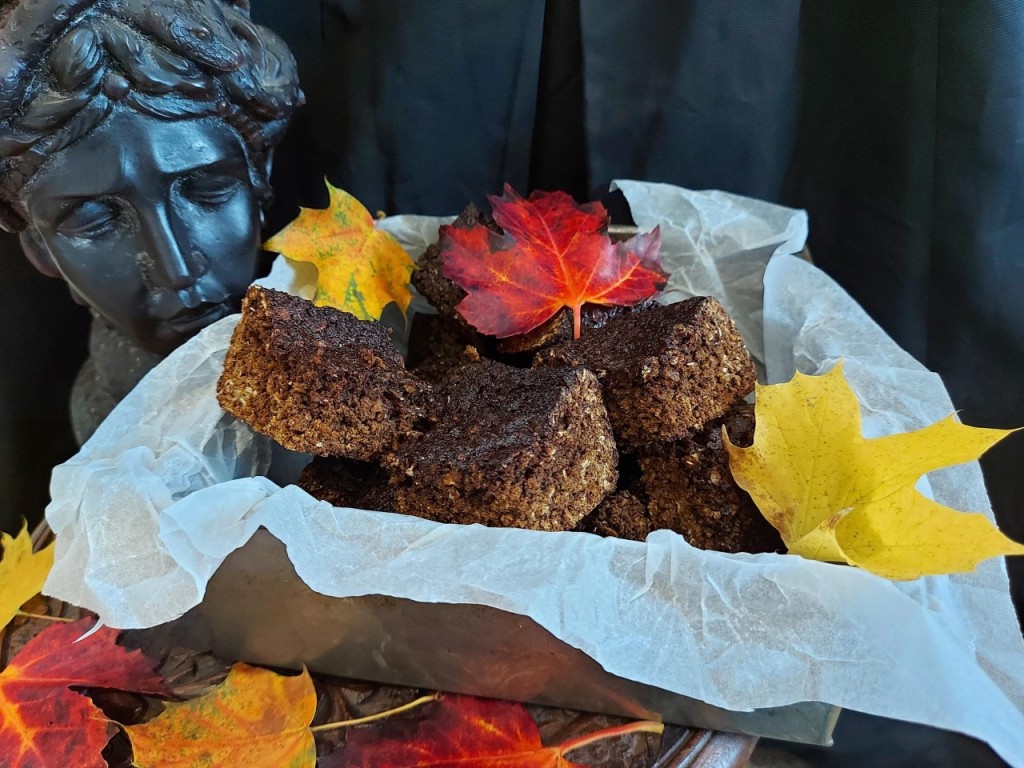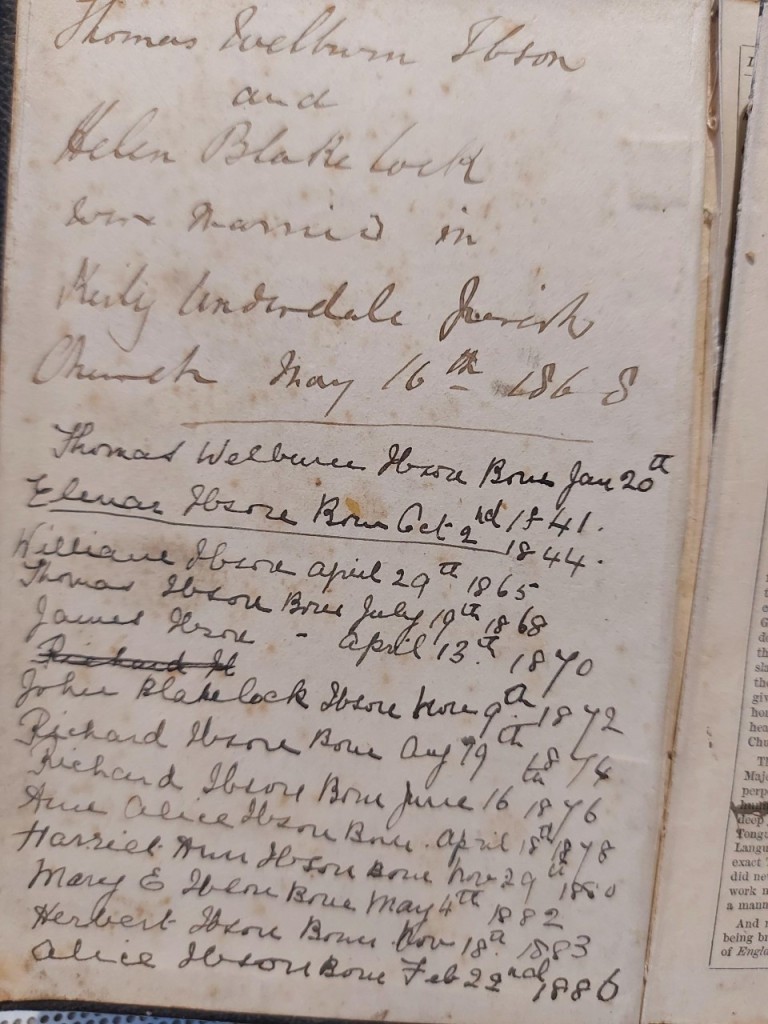
Strictly speaking, it should be the turn of Maimie’s book this week but, given that it’s the first week of November, it seemed only right to make Parkin. Traditionally a Yorkshire delicacy (although Lancashire and other Midlands and Northern counties make a version too), I turned to Harriet’s book and skipped a few pages to find her first Parkin recipe (oh yes, there’s more than one!)

Parkin was certainly well-known in the area that Harriet was from. I have one of her old books, a 1928 copy of The History of Kirby Underdale [the village where Harriet was born] by Rev. W.R. Shepherd. In it, he discusses ‘old words and customs’ and includes Parkin, describing it as a ‘gingerbread cake.’
Traditionally eaten on November 5th as part of bonfire celebrations, it is thought that Parkin has much earlier origins that were more likely related to All Souls Day on 2 November. Or possibly Samhain, a Gaelic festival marking the end of harvest and the beginning of winter, which falls on 31 October to 1 November. Or maybe Martinmas on 11 November. Who knows?! The theories behind Parkin are so numerous that Anne Fencott has written a gloriously comprehensive guide to the gingerbread and its origins, which runs to 241 pages.
The Rev. Shepherd tells us that Martinmas was the traditional time for servants to be hired. The end of the period was celebrated with a ‘sumptuous dinner. Its ample character gave a name to the day, Rive-Kite Sunday (Tear Stomach Sunday). A posset of spiced beer and treacle was drunk.‘ Given the use of spice and treacle in Parkin, perhaps this dense cake also contributed to the stomach injuries!
I followed Harriet’s recipe, halving the quantities and baking it for an hour; after consulting other recipes, I waited until the edge of the mixture began to come away from the sides. The smell was amazing – someone really needs to make a Parkin scented candle! On cooling, it was dry and stiff but I knew that I had to ‘mature’ it in order to soften it. I duly left it for more than a week but, sad to say, it didn’t improve. Not even custard was going to save it. I know that there are more Parkin recipes to try, both in Harriet’s book and also Althea’s (a Lancashire variety!), so I hope for a better result next year. In the meantime, I made this one in The Guardian, with better, more edible, results (sorry, Harriet).
On both Samhain and All Souls’ Day, it is believed that the veil between the worlds of the living and the dead is at its thinnest. It is also a time to honour and remember the dead, as well as free those poor souls in purgatory. So, how apt it was to come across Harriet’s family bible which finally gave some certainty as to who all of her siblings were:

My late mother spent several years researching Harriet’s siblings, trying to work out how many there were and when they lived and died. Her records indicated that there was a half-brother, seven brothers and three sisters. Finding this primary source though shows how ‘official’ records don’t always give an accurate story, and it also gives a more subtle indication of family relations.
In previous posts, I have written about Harriet’s illegitimate half-brother, who was born three years before her parents married. In all the ‘official’ records, he has his mother’s surname of Blakelock; indeed, although he was christened after his mother’s marriage to Thomas Ibson, he retained Blakelock as a surname. In this bible, however, he is listed as ‘William Ibson’. Does this mean that Thomas took him into the family as one of his own – as was often the case with illegitimate children? Or has the episode been ‘tidied up’ because they are documenting it in the family bible? I’m not sure about the latter theory of Christian politeness; there is certainly no disguising the fact that Thomas and Ellen’s was a shotgun wedding. They are married on May 16th 1868 and their son Thomas is born on July 19th 1868!
A sister appears in the bible, Anne Alice Ibson, born two years before Harriet. Online records had called her father James Welbourne, rather than Thomas. Sadly she died aged just 14 months old. The bible also throws up a mystery regarding ‘George Ibson’, whom my mother had identified as a sibling. There is no sign of any George in the bible and yet, the original parish records quite clearly show his baptism on April 17th 1881 and that Thomas Welbourne Ibson and Ellen Ibson are his parents:

A ‘Harriet Ann’ is listed below, with her parents being John and Rosanna Potter. ‘George Ibson’ never shows up in any of the Kirby Underdale records (or a twenty-mile radius), including censuses and birth, marriage and death records ever again. In the 1881 census, however, taken in the same month, a baby George Potter is living with his parents John and ‘Rosehannah’ at Brecknowm. It seems likely that whoever wrote the baptism records that day made a simple mistake and recorded the wrong child to the two sets of parents present that day. I hope that, by writing this down, I’ve rectified the mistake, honouring both George and Harriet, and perhaps releasing them from genealogical purgatory.

I have written parkin recipes on Red House Yorkshire and a Soul Mass cake, which you mention in this post. Will look at this more carefully and compare it to my too recipes. Might give it a go.
LikeLiked by 1 person
I think they are also called Harcakes, aren’t they, which is why people think that Parkin (sounds similar!) is related. Parkin is lovely but I wouldn’t use this recipe – too hard by far.
LikeLike
Not heard of Harcakes but have written about Havercakes – a thick oat pancake rather like pikelets or thin cruumpets.
Parkin is a nickname for Peter ??
LikeLiked by 1 person
Yes, that’s one of the theories too. All lost in the mists of time, I think!
LikeLike
I just love the idea of genealogical purgatory! As ever, the family and historical context is what brings these posts to life.
LikeLiked by 1 person
Thank you. I often think people must be bored silly by the family history bits, so that’s lovely to hear 🙂
LikeLike
Do keep the family history going! They sound an interesting lot, illegitimacy and all. Do you think the original parkin recipe might have responded to less cooking time? However, Felicity Cloake is always reliable, until she suggests icing parkin. ICING parkin? This Yorkshire woman is offended.
LikeLiked by 1 person
Oh, there’s plenty more family history in my spare room of doom (as we call it!), don’t you worry! Yes, I do think the Parkin was overcooked – even the Guardian one I tried suggested baking it for up to an hour and three quarters when an hour seemed to be ample. Iced parkin?! My grandma would beat her senseless with her pastry board for that one!
LikeLiked by 1 person
😉
LikeLike
Pingback: Finnan Haddock Squares | Eating With The Ancestors
Pingback: Bachelor’s Pudding | Eating With The Ancestors
Pingback: Ginger Bread | Eating With The Ancestors